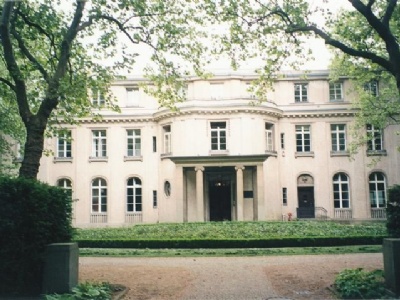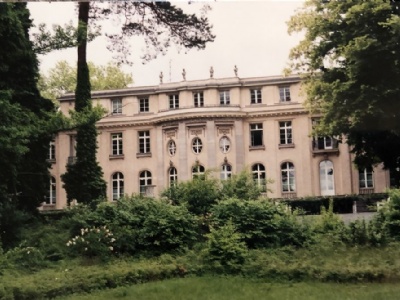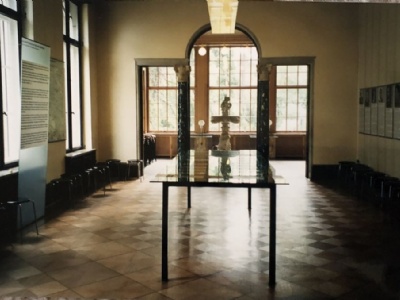Wannsee
On January 20, 1942, the head of RSHA, Reinhard Heydrich, held a meeting in Wannsee with representatives from various authorities to discuss the Jewish question. The meeting dates back to July 1941, when Heydrich received a written order from Hermann Goering to devise a final solution to the Jewish question. Most likely, it was Heydrich himself who designed the contents of the order and just handed it over to Goering for signature. Heydrich (and Himmler) considered the SS to be best suited to solve the Jewish question, and that is why SS and RSHA (Reichs Central Security Agency) asked for, and given, mandate to solve and coordinate the solution.
To achieve this, Heydrich understood that it would require extensive cooperation between SS, civil, local and military authorities to get it done. It had already been shown in Eastern Europe that cooperation was not entirely smooth. Now that the Holocaust was to be extended to the rest of Europe, and not just Eastern Europe, it was important that someone was given overall responsibility. Heydrich had sent out the invitations on November 19, 1941, and first it was planned to be held on December 9, 1941. But the Japanese attack on Pearl Harbor on December 7, 1941, forced Heydrich to postpone the meeting until January. According to Heydrich, "the purpose of the meeting was to coordinate the efforts of the relevant ministries and agencies in order to achieve the smoothest and most effective solution of the Jewish question".
The chairman of the meeting was Heydrich and the other 14 participants were with the exception of Heydrich of less political dignity and appear first at the middle level. For those who do not have a historical interest in Nazism and the Holocaust, other participants in the meeting are probably relatively unknown. Alfred Meyer, Gauleiter and secretary of state, the ministry of the occupied eastern territories. Georg Leibbrandt, Reichsamtsleiter, Ministry of the occupied eastern territories. Wilhelm Stuckart, lawyer, secretary of state. Erich Neumann, secretary of state and head of the agency for the Four-year plans. Roland Freisler, lawyer and secretary of state at the Ministry of Justice. Joseph Bühler, lawyer and secretary of state of the government of the General Government. Martin Luther, lawyer and deputy secretary of state. Gerhard Klopfer, Party Chancellery. Friedrich Wilhelm Kritzinger, secretary of state at the Reich Chancellery. Otto Hofmann, the race and settlement agency of the security services, RuSHA. Heinrich Müller, Head of the Gestapo. Adolf Eichmann, head of the Gestapo department on Judaism and secretary of the meeting. Karl Eberhard Schöngarth, the security police (SIPO). Rudolf Lange, security services of Latvia. Of these fourteen participants, no less than eight were doctoral students. The meeting lasted no more than about 90 minutes and it was served brandy, light snacks and the atmosphere among the participants was relaxed.
There were mainly two issues discussed at the meeting. First (1) it was discussed how the definition of the Jew itself. The Nazis had already before the meeting great problems with how to define persons mixed race. The germans introduced concepts such as mischlinge (a person with one or more non-Jewish parents or grandparents), privileged jew and unprivileged jew as an attempt to define the jews. Other problems were how Jews who had converted to or from Judaism or Jews who were married to aryans would be handled, would they be deported? And if so, when? The Jews who could most easily be defined as Jews could be deported first. No consensus was reached on when other Jews would be deported, but this had to be resolved at a later time. There were also a number of follow-up meetings where the topics discussed at Wannsee were discussed further, but not always with the same participants.
In eastern Europe, however, the definitions were not so carefully or important, but now it was about western European jews whose integration into society and social ties with the rest of the population were much stronger than they were in Eastern europe. The second (2) question discussed was which of the defined Jews were essential to the German war industry and thus would not be evacuated to eastern Europe in the initial stages. But regardless of what definitions were discussed, Eichmann had compiled a list of 11,000,000 Jews who were within the borders of Europe and therefore within the Nazi’s sphere of interest. Even within countries yet not occupied or under Nazi influence. Heydrich had good hopes that this would resolve itself, either through an occupation or through cooperation. Of these 11,000,000, some had already been murdered in connection with the invasion of the Soviet Union.
The bureaucratic and logistical issues that the final solution would entail were never discussed. The removal of the Jews of Europe was in line with ”The wishes of the Führer” and would be solved in Eastern Europe. Its legitimacy wasn’t something that the participants discussed or had any objections about. it was up to the individual and the authority they represented to solve the issue. No specific guidelines were discussed or presented at the meeting. For the participants representing the authorities from eastern Europe, it was mainly about making room for the large number of western European jews that were expected. It should also be added that cooperation and relations between the SS and civil authorities were often strained in Eastern Europe. In these cases, the main concern was who owned the ”Jewish Question” and how it would be solved.
For others, it was about preparing the gorund within their respective responsibilities. Mainly how laws would be adapted so that these corresponded to the actions planned. Discussing and planning the practical details of the issue was something that the participants of the meeting had to do when they returned to their respective workplaces. The meeting was concluded in consensus, where the participants understood that the Jewish question should not be hindered by either bureaucratic decision-making processes, logistical bottlenecks, financial constraints or individual self-interests.
The meeting brought up the fact that in Eastern Europe there were a large number of Jews who were incapacitated and that these should be "taken care" of first, but what this really meant was never discussed. By implication, all participants knew, or at least suspected, what was meant. How the Jews would be murdered was nothing discussed during the meeting, but it was up to each district to decide for themselves what was the most appropriate method. Heydrich also confirmed that the incapacitated Jews in the Lublin district would be "taken care" of first. Heydrich had already agreed this in the autumn of 1941 with Hans Frank, the supreme political leader of the General Government.
Current status: Preserved with museum (1998).
Address: Am Grossen Wannsee 56-58, 14109 Berlin-Wannsee.
Get there: Commuter train to Wannsee and then bus to the museum.
Follow up in books: Roseman, Mark: The Wannsee conference and the final solution, a reconsideration (2002).



The physical murder of the Jews grew gradually and had been preceded between 1933 and 1939 by social, legal, economic and political isolation. After the outbreak of war, the Nazi Jewish Policy was radicalized, which first affected the polish jews. Polish Jews were forced to wear identification marks and, starting in the spring of 1940, isolated ghettos were established in Poland to separate Jews from the rest of the population. In connection with the ghettoization, the situation of the Jews deteriorated through catastrophic living and working conditions and the occurrence of infectious diseases spread, not only in the ghettos, but also risked spreading outside the ghettos. The solution from the Nazis was to systematically starting murdering Jews who were sick or were no longer needed.
In 1940 and 1941, Nazi district leaders in the german empire began to demand the deportation of the district’s jews to eastern europe. Indeed, already in 1939 and 1940 German district leaders deported Jews from newly occupied territories and incorporated into the german empire. Jews were deported from western Poland to the General Government and Jews from Alsace-Lorraine to detention camps in southern France. But now the deportations would enter a larger phase, both geographically and by the number of people affected. The problem was that Nazi district leaders in Eastern Europe strongly opposed this due to lack of space. The attack on the Soviet Union would, however, create new conditions for expanding eastwards, thus freeing up areas where the Jews could be deported. Deportation of the jews from the german empire eastwards began in September 1941.
It is important to put the meeting in its proper historical context because the Holocaust affected different parts of occupied Europe at different times and not at the same time. When Heydrich sent out the invitations to the meeting, the slaughter of the Soviet Jews was already in full swing. In Auschwitz in September 1941, the Nazis tried Zyklon B and converted the camp’s morgue into a gas chamber. If not perhaps with the specific purpose of murdering Jews, but more as a consequence of Hitler in August 1941 stopped the Nazis systematic murder of mentally and physically disabled people. The Nazis simply had to transfer this murder operation into the concentration camps where it was easier to camouflage and keeping the secrecy around it.
In Birkenau they were in full swing in January 1942 with the construction of a provisional gas chamber (Bunker I). In the district of Warthegau and Lublin, the local nazis had begun construction of the Chelmno and Belzec extermination camps in November 1941 to solve the problems of the large number of unproductive Jews in the districts. In november and december the local nazis in Riga carried out mass executions of latvian jews to make room for german jews who were about to arrive soon. Involved in these mass executions were two of the participants of the meeting, Schöngarth and Lange. It was not only in Riga that local Nazis carried out mass executions during the winter of 41/42 to solve the problems of overcrowded ghettos or Jews who were no longer able to work. What might have happened if the Germans had defeated the Soviet Union is not clear. Had the Jews been deported to remote places further east in the Soviet Union or had the Jews been murdered anyway? This cannot be ascertained because the Nazi policy was adapted to the actual circumstances prevailing on the ground and therefore we cannot know for certain what would have happened if the Soviet Union would have been defeated.
What we do know is that the Jews deported from Western Europe in 1941 ended up in ghettos and were used as slave laborers. But it was really in 1942 that the deportation of the western european jews was speeded up and they (including those deported in 1941) came to suffer the same fate as the eastern european jews. Nazi policy towards the Jews entered its most extreme phase in 1943 when previously occupied territories were abandoned and the final dismantling of the ghettos began. This meant that the Jews who were not absolutely necessary for the German war industry were murdered. At the same time, the deportations of West and South European Jews continued at an unabated pace. In the spring of 1944, Hungary was also occupied and about 400,000 Jews were deported to Auschwitz and murdered. In 1943 and 1944, deportations usually went directly to a extermination camp or a execution site because there were no ghettos or camps to place them in.
The meeting came when it became known after the war to be called the Wannsee conference, but neither Heydrich nor any other Nazi called the meeting a conference. Most likely, it is a term created by historians to give it a greater historical significance and distinguish it for other meetings. The concept of meeting has a common meaning, while conference is something bigger and more important than a meeting. Similar meetings took place at a lower local level, primarily in the Soviet Union, where Nazi leaders in charge decided the fate of the Jews. The meeting is either, as claimed sometimes, a meeting where the Nazis decided to kill all the Jews. The meeting was one of several links in a process that went on continuously between 1933 and 1945, a process that was adapted to the actual circumstances surrounding its historical context.
It is likely that the participants themselves did not see the meeting as anything out of the ordinary. It is also not possible to track any major activity among the participants following the meeting, which indicates that the process was already underway. In fact, we really know very little what the participants did after the meeting. Exceptions are Heydrich and Eichmann, who we know returned to their everyday tasks. But what was important for Heydrich was that he showed the participants that it was SS who had taken on the task of solving the Jewish question. Other authorities who might have had own claims on the Jewish question had to reconsider and get in line. The meeting can be seen as a success and demonstration of power by Heydrich, through which he built a power base for the SS and its future role in Eastern Europe. SS never recieved any specific order from Hitler where they were commissioned to kill the Jews. But they were the driving force behind the killing and took the lead to accomplishing it.